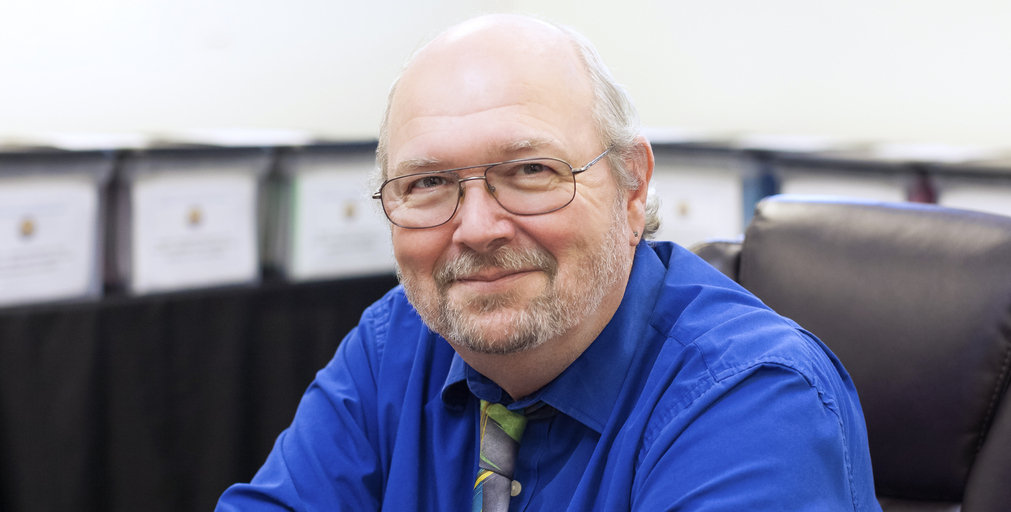George Griffin entered the public speaking field long before he started teaching in it. As a high school student, he participated in local speech and debate competitions and was so successful he won a contest that covered a portion of his freshman year college tuition.
While at the University of West Florida for his undergraduate degree, he continued to participate in debate and speech competitions—the proceeds of which covered the rest of his tuition. “It was an easy thing to get into,” Griffin said. “I found that I had a natural ability for it.”
During his graduate assistantship at Auburn University in Auburn, Alabama, Griffin coached the undergraduate speech and debate teams, but chose to enter the business management field when he finished his studies. But Griffin couldn’t stay away from public speaking and ventured into his community to see what teaching opportunities were out there. For years, he worked part-time instructing workshops, professional development sessions, and occasional community college classes and started to develop a passion for it. Looking to move more firmly into education, he began teaching part-time at Daytona State College in Daytona Beach, Florida.
The Turn to Teaching
In 1995, Griffin joined the faculty as an adjunct professor at Stetson University in Deland, Florida, teaching Introduction to Public Speaking—a class he continues to teach at Stetson to this day. As one of the most popular introductory-level courses at the university, hundreds of students over the years, regardless of their major, have made their way through Griffin’s classroom.
It’s because of this, as well as Griffin’s responsibilities as a faculty member at Keiser University in Orlando, that he recognizes the importance of the practical skills he teaches in his classes. “Learning how to write and deliver a speech, and overcome nervousness, makes this one of the most important classes a student can take,” Griffin said. “It’s an empowerment course and once students learn to express themselves effectively, there’s no stopping what they can do.”
Despite his belief in the importance of public speaking as a subject, Griffin always had trouble with instruction materials. In his 30-year teaching career, he used dozens of different public speaking textbooks. Yet, he never felt any sufficiently equipped him with adequate teaching tools or provided students with the learning resources necessary to deliver oral presentations. For example, the topic of anxiety for public speakers was rarely, if ever, discussed—a big issue for Griffin since this was central to why most of his students took his course. “If you ask any public speaking class on day one what they want to learn from this course, the overwhelming answer you’re going to get is, ‘help me overcome my nervousness,’ Griffin said. “And yet the average textbook spends one to two percent of its time on that topic.”
Teaming up with Top Hat
Griffin is lead author of Top Hat’s Effective Public Speaking textbook, which was written specifically to accomodate large class sizes. When writing the textbook, he knew right away that nervousness and stage fright would be significant components of the textbook material—it’s a major reason he included interactive video solutions and specialized content to address anxiety around public speaking, as well as emphasize competence, confidence and practical skill development.
Public speaking can be nerve-wracking, but Griffin believes the whole point of the college experience is for students to get out of their comfort zones. That’s why he feels it is important to build a rapport and an open environment with his students right away, recognizing that once students realize they won’t be judged, they are much more willing to learn from their own mistakes in a public setting.
Griffin liked that Top Hat’s interactive learning platform had a wide variety of educational activities and assessments available making it simple to convey public speaking materials in an engaging way. The feedback on these integrated interactive learning tools was clear: students were coming to class and they were engaged in course material.
Griffin appreciates the way his Top Hat textbook holds students accountable for their own learning. “The fact that I can open up a chapter and see who’s reading the chapter, who’s answering the questions and who’s getting the answers right is essential,” Griffin said, “I would never have that kind of accountability in a traditional textbook.”
And while Griffin understands the hesitation of pivoting to a fully digital course platform, over fears of decreasing student engagement and distraction, his experience has actually been the opposite with Top Hat’s platform. “We have a tendency to think students are distracted in the classroom because of technology, but it’s only because we’re not using it properly. If we get them using the technology to participate, we’re going to do a whole lot better in our classrooms,” he said.
George Griffin is currently a Professor of Speech at Keiser University, Orlando and an Adjunct Professor at Stetson University. He has been teaching college, business seminars and workshops for over 30 years, while undertaking public speaking engagements for non-profit organizations. He is also the author of STAGE FRIGHT! A Student-Friendly Guide to Managing the Jitters. He holds degrees from the University of West Florida and Auburn University.


